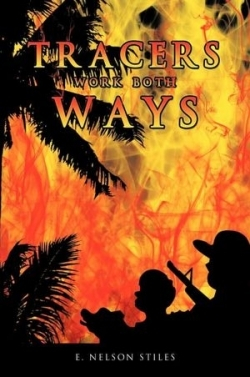Tracers Work Both Ways
One of the toughest challenges faced by a novice novelist, beyond self-editing, is defining the hero. The hero emulates the story’s moral core, which in turn allows readers to identify with the character or buy into the story. The lack of a moral core in E. Nelson Stiles’ Tracers Work Both Ways is just one problem limiting the story’s potentially interesting plot.
Set in the present day United States, this thriller begins with near-global destruction. A bright green flash lasting twenty-eight seconds fills the sky. Anyone using an electronic device is killed. Stiles borrows heavily from John Wyndham’s The Day of the Triffids, and survivors not under cover at the time of the flash are left blind.
The science in Stiles’ science fiction novel is thin at best. All electronic devices, including vehicles with computer chips, are fried when the flare strikes. But just as it becomes difficult to imagine a complex world operating without electronics, working computers are found, phone lines are laid, and high-tech helicopters are in working order. The flash itself is never fully explained beyond a character’s guess that “planetary alignment in the solar system created enormous solar flare eruptions and mass ejections.”
The surviving citizens quickly form groups and gangs—mimicking the racial divisions between street and prison gangs—as they battle for control of the land, transportation routes, and remaining resources. As society begins to rebuild, Stiles follows Kurt Weinstock, an everyman who is nearing retirement age, and Kevin Martin, a Navy frogman who was thrown in the brig for abusing prisoners.
Neither character works as a believable hero. Both work with the Aryan Brotherhood and praise its efficiency. Neither has much respect for the “Africans” beyond their own token friends. Kevin slaughters one of his own crew in cold blood, allows his men to collect scalps, and oversees a graphic torture scene. Weinstock guarantees that no soldier will be punished if the camera on his weapon shows evidence of wrongdoing (this guarantee is issued after he hears that the soldiers are worried “some pogue will be reviewing the video to see if anyone accidentally wasted a kid”).
Moral complexity and moral ambiguity can be thought-provoking, but both require a base level of morality that a reader can connect with. Lacking that base, Tracers Work Both Ways reads like a technophobic white supremacist’s fantasy.
Reviewed by
Joseph Thompson
Disclosure: This article is not an endorsement, but a review. The publisher of this book provided free copies of the book and paid a small fee to have their book reviewed by a professional reviewer. Foreword Reviews and Clarion Reviews make no guarantee that the publisher will receive a positive review. Foreword Magazine, Inc. is disclosing this in accordance with the Federal Trade Commission’s 16 CFR, Part 255.

